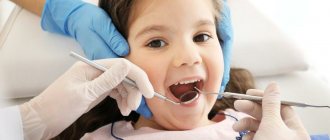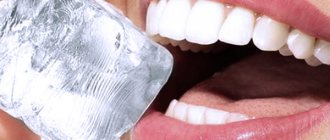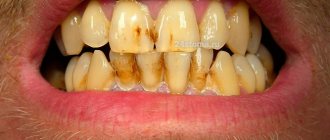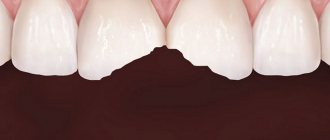Main causes and degrees of mobility
Before considering how to save a loose tooth, it is important to identify the main factor that caused it. Possible reasons include:
- mechanical damage (trauma). As a result of various bruises, damage to the periodontal tissues and root displacement occur. It is worth noting that if the tooth remains in the socket, it is enough to carry out strengthening procedures to save it;
- genetic predisposition. For patients with poor heredity at any age, it is important to take preventive measures to strengthen teeth in order to avoid problems in the future;
- periodontal diseases (for example, gingivitis, periodontal disease). They make the roots weak, causing bleeding and swelling. In the absence of timely treatment, the gums will become loose, which will lead to mobility and loss of teeth;
- bruxism (“teeth grinding”). Very often, bruxism bothers you at night. In such situations, it is recommended to wear special protective equipment during sleep;
- abuse of alcohol and tobacco products. They weaken the body’s protective properties and have a destructive effect on bone tissue, which can lead to instability;
- poor nutrition. People who abuse junk food, neglecting foods with healthy vitamins, minerals and trace elements, often complain of dental problems. In such situations, it is important to start eating a balanced diet and drinking a vitamin complex;
- systemic diseases (osteoporosis, thyroid dysfunction and other abnormalities of the endocrine system). They have a negative impact on the condition of the entire body;
- age. Over the years, due to deterioration of blood supply, bone tissue atrophy gradually occurs, which leads to loose teeth;
- low immunity (for example, due to recent chemotherapy). Since the body lacks the strength to resist, the most vulnerable parts suffer first, the oral cavity being one of them;
- pregnancy and lactation period. The body experiences an acute shortage of microelements and vitamins, and hormonal surges occur. This all affects the condition of the oral cavity;
- uncontrolled use of certain medications.
In this case, four degrees of mobility are distinguished. In the first, the teeth deviate slightly to the side (less than 1 mm). On the second, the amplitude increases (by more than 1 mm). On the third, they deviate in all directions. On the fourth, they are able to rotate around their axis. The answer to the main question: “if a molar tooth is very loose, can it be saved?” positive. But this requires long-term complex treatment.
Treatment
Most often, the ability to loosen is found in the front teeth. Treatment is carried out in several stages.
- Make an appointment with your dentist to find out the cause.
- If the teeth begin to become loose due to any chronic disease, a consultation with a specialized specialist (rheumatologist, endocrinologist, etc.) will be scheduled.
- Professional teeth cleaning is carried out - this procedure should be carried out in a dental office. It helps get rid of soft and hard deposits on the enamel.
- An x-ray of the front row of teeth is taken. If mobility is noted after injury, usually only one tooth is loose.
- If a fracture is detected in the root area, minor surgery is performed to remove the fragment.
If the molars are loose, the search for the cause is carried out as follows:
- When only one molar is loose, this most often means the presence of a cyst. This formation usually occurs at the top of the root. Treatment in this case is determined by the dentist. To strengthen teeth, therapeutic or surgical treatment may be prescribed.
- If not one, but several molars are loose, diseases such as periodontitis or periodontal disease are most often suspected. In order to strengthen teeth, mandatory oral hygiene is prescribed. For periodontitis, anti-inflammatory therapy is carried out. Physiotherapy and gum massage are also prescribed.
- Curettage, removal of deposits accumulated under the gums, gingivectomy, and gingivotomy may be prescribed. The procedures involve excision of gum pockets.
- When malocclusion is recognized as the main factor in the development of pathology, therapeutic treatment is required, during which braces or special simulators can be used. They help distribute pressure evenly on the jaw.
- Bruxism uses a device called a mouthguard. It is placed over the teeth before bed to prevent teeth grinding.
The most effective method of treating loose teeth is splinting them. In this case, a splint is installed on the dentition - a special device that helps fix loose teeth and correctly distribute the load between diseased teeth and healthy ones.
Whatever the cause of the pathology, the condition of the oral cavity must be closely monitored. It is useful not only to maintain oral hygiene, but also to periodically rinse with antiseptic compounds to protect yourself from infections. For the same purpose, strengthening the immune system is carried out. It is also worth giving up bad habits that cause rapid tooth decay.
Is it possible to save a loose tooth?
If the cause of mobility is pathological processes in the gums (for example, periodontitis, gingivitis), then the doctor determines the infectious or non-infectious etiology, removes plaque and stone, and prescribes a course of therapy. If the cause of unsteadiness is an incorrect bite, they resort to orthodontic treatment (wearing trainers, braces).
Many patients wonder whether a loose molar can be saved with splinting. This is an effective technique that helps strengthen loose teeth by fixing them in one position. It comes in several types:
- extracoronary (the structure is applied and fixed with cement);
- occlusal (involves the use of an overlay or mouth guard);
- intracoronary (includes drilling a hole into which the splinting element is attached).
Most often, during the procedure, the doctor makes a small groove along the dentition into which the splint is placed. It is made of durable fiberglass and is hardly noticeable in the oral cavity. The doctor carefully closes the groove with photopolymer filling material, which allows maintaining aesthetics and functionality.
Splinting is divided into temporary and permanent. Temporary involves fixing structures for a specific period of time so that periodontal tissues have time to recover. The composition of splinting mixtures includes components that allow you to quickly restore stability to the dentition.
How to pull a tooth without pain for children using gauze
First, make sure that the tooth is not deep enough in the gum, and that the gum itself is loose. To do this, you will need clean gauze and an antiseptic. Using moistened gauze, grab the tooth from the sides and slowly rock it in different directions. If the gums are plastic, there is no swelling or redness, you can safely proceed.
- Set your child up for positivity and distract him from obsessive thoughts.
- Feed the baby, because after pulling out, you will not be able to eat for 2-3 hours
- Clean and rinse your baby's mouth.
- Place him on a chair so that the oral cavity is well lit.
- Take the tooth by the tooth with gauze soaked in antiseptic, and begin to slightly swing it in the direction from the gums.
- As soon as you feel that the tooth is not offering much resistance, pull it out with a sharp movement.
- Carefully monitor the condition of the wound after tooth extraction. To do this, you need to apply a cotton swab with an antiseptic, for example Chlorhexidine, to it and hold it for half an hour. It is important that it does not get infected.
In the first day after the intervention, the gums may become inflamed. Procedures for cooling it will help - compresses lasting up to 10 minutes. If necessary, the child can be given an anesthetic in an age-appropriate dosage. Then the mouth can be rinsed with chamomile or mint decoctions with a strong disinfectant and analgesic effect.
A tooth started to loosen: how to save it at home
If a tooth is loose, you can save it at home (as part of complex therapy). In the initial stages, massage of the gums and the area around the loose tooth helps. It is important to perform it systematically (twice a day for 3–4 minutes). Problem areas are massaged in a circular motion without causing excessive stress. After each massage session, it is necessary to rinse your mouth with a decoction of medicinal herbs (for example, chamomile or sea buckthorn).
Also, at home you need to use gels that relieve inflammation and improve blood circulation in tissues (as prescribed by a doctor) and adjust your usual diet (add foods rich in vitamins and minerals).
Loosening of baby teeth
When teeth change in children, which most often begins at the age of five or six, loose teeth are not a cause for concern. The tooth begins to wobble due to root resorption, then falls out, and another one gradually grows in its place. After the tooth root has resolved, its crown rests on the gum. That's why loosening occurs.
There is no need to speed up this process - it’s better to try to let everything happen naturally. The child should be given something solid to eat more often - for example, an apple, carrots. Parents should be wary only if the child begins to chew on one side of the mouth and experiences severe pain. Medicinal pastes and gels can be used to temporarily alleviate the child’s condition, but you should consult a doctor as soon as possible.
If you notice swelling on your baby’s gums, inflammation, or general deterioration of the condition, contact your dentist to determine the causes and receive recommendations for treatment. A timely examination helps to avoid serious dental health problems.
Advantages of visiting Dr. Martin dentistry
The network of dental clinics "Doctor Martin" was awarded the honorary title of dentistry with European quality of treatment. Despite this, the pricing policy is loyal, the cost of the services provided is affordable, discounts and special offers are regularly held (more details on the price list can be found on the website). Every patient is guaranteed free consultations.
To make an appointment with a specialist, you can contact the administrator at the numbers provided or leave a request on the website. At the initial appointment, the doctor will collect an anamnesis, conduct an examination,, if necessary, prescribe a diagnosis and tell you how to save a loose tooth in a particular case. Thanks to the extensive experience and highly qualified specialists, it is possible to cope with even advanced clinical situations. Don't delay, make an appointment right now!
Removal of the first teeth
Often, when removing a baby tooth that has already begun to loosen, anesthesia is not required. In such cases, the presence of a dentist is not always necessary - the baby will be able to cope with the task himself. You can only help him a little - provide hard vegetables and fruits, such as carrots or apples, as loosening materials. If, after a tooth falls out, bleeding begins, it can be stopped using a cotton swab with chlorhexidine or another safe antiseptic. If the baby throws a whole tantrum, cannot pull out a tooth on his own and is not given to his parents, then it is better to use the services of professionals - they will help the baby quietly and without pain. The main mistake parents make is often their own panic, which is passed on to the child. In this case, on the contrary, they need to support their child - use as an example one of the children they know who has already had their teeth pulled out, or praise the baby for his heroism. In any case, the support of relatives in the dental chair will be invaluable for the child.











